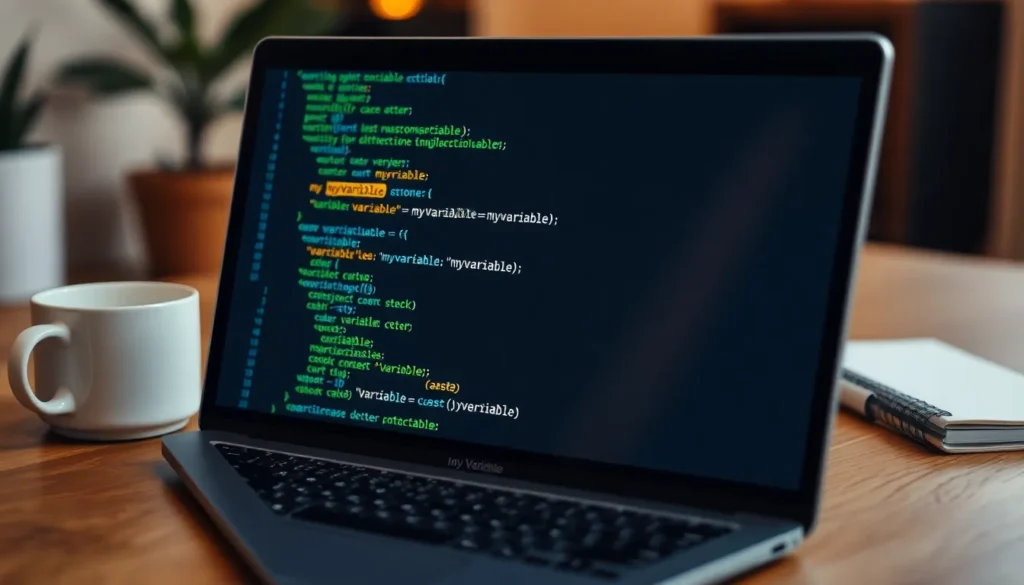When diving into the world of Python programming, one question often slithers to the surface: is Python case sensitive? Picture this—you’re crafting the next great app, and a sneaky typo sends your code spiraling into chaos. It’s like trying to order a pizza but accidentally asking for a salad. Yikes!
Table of Contents
ToggleUnderstanding Case Sensitivity
Python is a case-sensitive programming language. Identifiers such as variable names and function names must maintain consistent casing to function correctly. For instance, if a developer defines a variable as myVariable, attempting to access it as myvariable results in an error. This behavior emphasizes the importance of adhering to precise character casing.
Another key aspect involves built-in types and methods. Methods like append() and extend() differ in case; using Append() will not produce the desired outcome. Developers must use the correct casing when invoking these methods.
Consistency in how identifiers are written matters greatly. Writers often adopt naming conventions to avoid confusion. Common practices include using all lowercase letters for variables and functions, while class names typically use CamelCase. These conventions enhance readability and help maintain clarity.
Errors related to case sensitivity can cause frustrating debugging experiences. Even subtle variations in case can lead to misleading error messages that waste valuable time. Understanding this aspect of Python not only prevents mistakes but also aids in effective collaboration within larger coding teams.
Case sensitivity also influences the usage of libraries and modules. When importing or calling functions from external libraries, it’s critical to respect the original casing used by those libraries. Ignoring this may result in unexpected behavior, confirming that case sensitivity significantly impacts code functionality.
Familiarizing oneself with these nuances enhances a programmer’s efficiency in Python. Greater attention to detail combined with consistent practices translates into more robust code and fewer runtime errors.
The Basics of Python Case Sensitivity

Python is a case-sensitive programming language. This property means identifiers like variable and function names must maintain consistent casing to function properly.
What Does Case Sensitivity Mean?
Case sensitivity refers to the distinction between uppercase and lowercase letters in Python. In this context, myVariable differs from myvariable. When naming variables or functions, the exact casing must be respected. Any variation leads to errors, making understanding this concept crucial for coding in Python.
Examples of Case Sensitivity in Python
Numerous examples illustrate Python’s case sensitivity. For instance, if a user creates a variable named Data, attempting to access it as data generates a NameError. A list method like append() must be used precisely. Calling it as Append() also results in an error. Such specific examples highlight the importance of accurate casing, especially in importing libraries and calling their functions.
Implications of Case Sensitivity in Coding
Case sensitivity in Python has significant implications, particularly for variable naming and function calls. Understanding these elements enhances code clarity and functionality.
Variable Naming Conventions
Variable names in Python must maintain consistent casing to function correctly. Best practices suggest using all lowercase letters for variable names, as this enhances readability. For instance, a variable named user_age clearly communicates its purpose. Mixing cases, such as using UserAge, can confuse both programmers and readers. Adhering to a consistent naming convention reduces the risk of errors. Developers should also avoid using Python’s built-in names, like list or str, as variable names. This prevents name shadowing issues, which can complicate debugging. Following these conventions ensures effective collaboration and reduces the likelihood of introduction of bugs.
Functions and Method Calls
Functions and methods in Python are also case-sensitive, making correct casing essential. Calling append() or extend() using the wrong casing, such as Append(), results in an error. Differentiating between built-in functions and their respective names leads to fewer coding hurdles. Understanding function names helps streamline both reading and maintenance of code. Defining custom functions should follow similar casing rules as built-in methods to maintain consistency. When using external libraries, respect the original casing of functions and classes, as this ensures proper functionality. Accurate casing in function and method calls promotes a smoother coding experience and minimizes frustrating runtime errors.
Common Mistakes Related to Case Sensitivity
Case sensitivity in Python often leads to common errors among programmers. Accessing a variable with incorrect casing results in a NameError, exemplifying this issue. For instance, using myvariable instead of myVariable will cause the program to fail.
Variable naming practices can significantly mitigate case sensitivity mistakes. Utilizing all lowercase letters for variables improves clarity and reduces confusion. Following this convention helps prevent unintentional errors during coding.
Common methods also exhibit case sensitivity nuances. Methods like append() and extend() differ in their casing. Calling Append() instead of append() will produce an error. Misunderstanding these differences can lead to frustrating debugging sessions. Additionally, confusion might arise from libraries, which require adherence to original casing. Importing a library function with incorrect casing may result in runtime errors.
Best practices include avoiding built-in names for variables. Shadowing built-in functions can complicate code and cause unexpected behavior. Promoting consistent naming conventions fosters better collaboration among teams. Errors often multiply when developers do not respect casing in function calls.
Learning case sensitivity ensures smoother coding experiences. Missteps in casing can lead to time-consuming troubleshooting that distracts from project goals. By prioritizing accurate casing, programmers not only reduce bugs but also enhance overall code quality. Emphasizing these practices throughout the coding process leads to more robust applications and effective team collaboration.
Understanding Python’s case sensitivity is essential for anyone looking to write effective code. By recognizing that identifiers must be used consistently in terms of casing, programmers can avoid frustrating errors and enhance code readability. Adopting best practices like using all lowercase for variables and CamelCase for classes can further streamline the coding process.
By respecting the nuances of case sensitivity, developers can not only reduce debugging time but also foster better collaboration within teams. Ultimately, prioritizing accurate casing leads to cleaner code and a more efficient programming experience.








